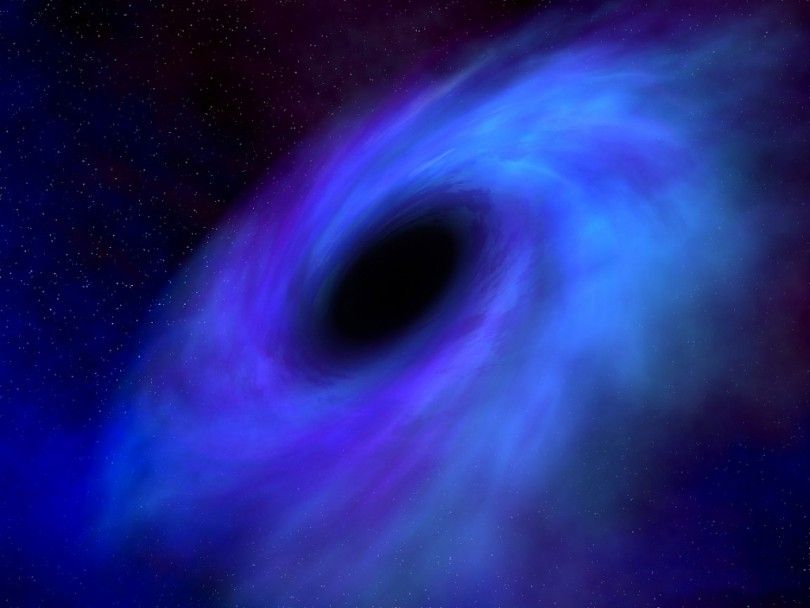Астрофизики из Гарвардского университета (США) нашли первые доказательства существования гигантских черных дыр, возникших в результате прямого гравитационного коллапса огромных облаков газа, без его превращения в звезды, сообщает Space.com. Такие чёрные дыры могли рождаться только в первые эпохи жизни Вселенной.
A bright galaxy in the early universe likely contains a mysterious kind of black hole that had previously existed only in theory, a new study suggests.
This probable “direct-collapse” black hole may help explain howsupermassive black holes — the light-gobbling behemoths that lurk at the hearts of most, if not all, galaxies — got their start, researchers said.
“The special aspect of this [direct-collapse] process is that it leads to the formation of a very massive ‘seed’ black hole in one go,” study co-author Avi Loeb, chair of the astronomy department at Harvard University, told Space.com via email. “It is difficult to make such a giant black hole over such a short time if they start from low-mass seeds.” [Images: Black Holes of the Universe]
Death by gluttony
When a massive star reaches the end of its lifetime, it can collapse inward on itself to form a black hole. These dense objects then grow by feeding on surrounding gas and dust, but the process can take time.
Indeed, it probably takes quite a while for such a small seed to grow into a supermassive black hole, which can contain billions of times more mass than the sun, scientists say. This poses a puzzle: Where, then, did the supermassive black holes in the early universe come from?
Some of these monsters existed only 750 million years after the Big Bang that created the universe, Loeb said. (Scientists know this because they have spotted quasars — incredibly bright galactic cores powered by supermassive black holes — of this vintage.)
“It is difficult to make such a giant black hole over such a short time if they start from low-mass seeds,” Loeb said.
In 2003, Loeb and Volker Bromm of the University of Texas at Austin (UT Austin) — also a co-author of the new study — theorized that clouds of dust and gas in the early universe were so hot that they failed to fragment into multiple clumps of thousands of stars. Instead, such clouds likely created just a single massive star at the center, roughly 1 million times larger than “normal” stars, Loeb said.
Such gigantic stars would quickly consume all of the nearby gas and dust. Overeating would lead to a rapid demise; these stars would last only a few million years before collapsing into midsized black holes that could continue to feed, ultimately growing into the giants that lie at the centers of galaxies.
To stay so superhot, the gas at the heart of this process would need to be almost purely hydrogen and helium, without “heavier” elements to help cool it down. Since heavy elements are produced in the hearts of stars and then released during a supernova, such “direct-collapse black holes” could only form in the early universe, the researchers said. [The Universe: Big Bang to Now in 10 Easy Steps]
But there hadn’t been much evidence for this idea — until now.
From prediction to reality
Last year, astronomers spotted a strange signal from a galaxy known as CR7, one of the most luminous objects in the early universe. Although the galaxy showed signs of temperatures greater than 180,000 degrees Fahrenheit (100,000 degrees Celsius) and signatures of helium atoms gaining and losing electrons — a process known as ionization — there were no signs of other elements.
“That makes the galaxy that we have discovered really unique, and ticks all the boxes for predictions for both first-generation stars or a direct-collapse black hole,” David Sobral, an astrophysicist at the University of Lisbon in Portugal, told Space.com.
Sobral led the team of astronomers that identified irregularities in CR7 last year and other similar galaxiesmore recently. In their paper, they argued that, while CR7 could contain a direct-collapse black hole, the unusual signal favored a cluster of the universe’s first stars.
“Regardless, the actual material — pristine gas — to make either first-generation stars or a direct-collapse black hole is essentially the same, and it is extremely exciting to finally start asking actual physical questions about the nature of the very early galaxies,” Sobral said. “This goes way beyond the traditional approach of simply counting distant galaxies.”
Sobral and other scientists will continue to observe CR7, with instruments such as NASA’s Hubble Space Telescope and the Atacama Large Millimeter/submillimeter Array in Chile. But other research teams are investigating the galaxy’s origin and evolution via computer modeling and other work.
Fabio Pacucci, a Ph.D. student at Scuola Normale Superiore in Italy, was part of one such team, whose research argued for the black-hole theory in a paper last year. But those researchers’ observations of CR7 weren’t definitive.
“Unfortunately, we do not see any X-ray emission from this source, which would be a smoking gun to say that it is a black hole,” Pacucci said.
That’s where Loeb and Volker come in. They’re members of another research team, led by Aaron Smith of UT Austin, that sought to solve the mystery.
Smith and his colleagues developed what Smith called “a novel code” to simulate both the black-hole and the first-star scenarios using a supercomputer at UT Austin. The star scenario “spectacularly failed,” Smithsaid in a statement, while the direct-collapse model held up.
“The evidence [for a black hole] is conclusive,” Loeb told Space.com.
After predicting the existence of direct-collapse black holes more than a decade ago, Loeb is excited to see them confirmed by observations.
“It feels good to come up with an idea about how nature might work, but it is exhilarating to find out that nature really behaves the way you thought it does,” Loeb said. “The experience is as rewarding as getting love back from a person you love.”
Smith and his colleagues published their results last week in the journal Monthly Notices of the Royal Astronomical Society.
«Размеры черных дыр первых дней существования Вселенной свидетельствуют, что их рождение из небольшого звездного «зародыша» было крайне маловероятным – они просто не успели бы накопить достаточно массы за время своего существования», — считает один из участников исследования, Абрахам Лоеб (Abraham Loeb).
Учёные пришли к такому выводу, наблюдая за несколькими древнейшими галактиками. Благодаря их невероятной удаленности, мы видим их такими, как в первый миллион лет жизни мироздания после Большого Взрыва. Специалисты изучали распределение облаков из газа и пыли в этих галактиках и как они устроены. Облака «нормальных» современных галактик очень неоднородны по своему составу – в них присутствуют более плотные и менее плотные области – в результате такие скопления постепенно распадаются на части, и в более плотных участках рождаются звезды.
Почти 15 лет назад Лоеб и его коллеги предположили, что в первых галактиках Вселенной этот газ, благодаря почти полному отсутствию в нем пыли и элементов тяжелее водорода и гелия, мог быть гораздо более однородным. Если такое облако достигало очень больших размеров, вмещая в себя миллионы или даже миллиарды масс Солнц, то оно превращалось сразу в сверхмассивную черную дыру.
Сейчас учёным удалось найти намеки на то, что всё так и происходило, в галактике CR7, одной из самых ярких «звездных семей» ранней Вселенной. Она была найдена в прошлом году при помощи телескопов VLT и «Хаббл». Группа Лоеба не обнаружила в её звездах и газе следов присутствия элементов тяжелее гелия – это стало первым намеком на наличие облаков, в которых рождаются чёрные дыры.
Вторым – стало присутствие в CR7 нескольких крупных облаков газа, внутри которых, как показывают расчеты, могут родиться сверхмассивные чёрные дыры, а не особо крупные звезды или скопления новых светил.
Пока учёные не зафиксировали рентгеновского излучения, главного следа рождения черной дыры, однако они уверены, что в этих облаках вряд ли может возникнуть что-то иное – для рождения светил внутри них слишком жарко.
Как отмечают исследователи, подобные чёрные дыры являются относительно редкими обитателями космоса – они могли формироваться только в первые эпохи жизни Вселенной. Сегодня они просто не могут возникнуть из-за того, что первые поколения звезд «замусорили» все галактики тяжелыми элементами.
Если вы нашли ошибку, пожалуйста, выделите фрагмент текста и нажмите Ctrl+Enter.








Сообщить об опечатке
Текст, который будет отправлен нашим редакторам: